1lumen selects and reviews products personally. We may earn affiliate commissions through our links, which help support our testing.
Lumintop Gift-G1 Turbo Glow review

Lumintop Gift-G1 specifications
| Brand/model | Lumintop Gift-G1 |
|---|---|
| LED | Nichia 219C (this review) or Cree XP-G3 |
| Lumens | 500 lm (Nichia ) / 600 lm (CREE) |
| Beam intensity | 4050 cd / 125m |
| Battery config. | 1*14500 / |
| Material | Aluminum |
| Modes | 4 |
| Blinkies | Strobe |
| Reflector | TIR optic |
| Waterproof | IP68 |
| Review date | May 2021 |
Introduction:
It glows!
Now that’s out of the way, let me introduce the Lumintop Gift-G1.
I’m not sure if Lumintop needs much introduction: they’re behind the GT series of Lumintop flashlights, as well as the FW3A. Lumintop are well known for making a good light, then turning it into a series and selling lots of slight variations. At the time of writing the Gift-G1 is the only one in the series but by the time you’re reading this I’m betting that there will be a few spin-offs to choose from.
There are different colour options though: this one is green (which supposedly glows best) but Lumintop also sell the Gift-G1 in red, blue, pink, and purple. I’ve also seen photos of a multi-colour version but don’t see it for sale.
Aside from the GITD (glow-in-the-dark) body and light-up tailcap, the Gift-G1 (or just G1) is most similar to their EDC AA, which doesn’t glow at all. If this level of glow is too much for you then Lumintop also has a version of the EDC AA with a glow in the dark bezel. Lumintop also has a very-glowy FW3A variation called the FW3G.
You’re probably interested in the Gift-G1 because of its ability to glow and the lighted tail cap. Read on to find out how well they work and if the Gift-G1 still retains the EDC-ability of the EDC AA.
The Gift-G1 package is surprisingly small. It’s printed cardboard, with a cut foam insert. In the box you’ll find:
- Lumintop Gift-G1
- Bright yellow lanyard
- Tactical ring (for cigar grip)
- 2 spare o-rings (clear)
- User manual (English and Chinese)
The flashlight was in a vacuum sealed plastic bag, to stop the copper from oxidising.
Of note, there’s no clip provided with the Gift-G1. I’m not sure how well an after-market one would work either, due to the GITD body.
There’s no battery in the box.
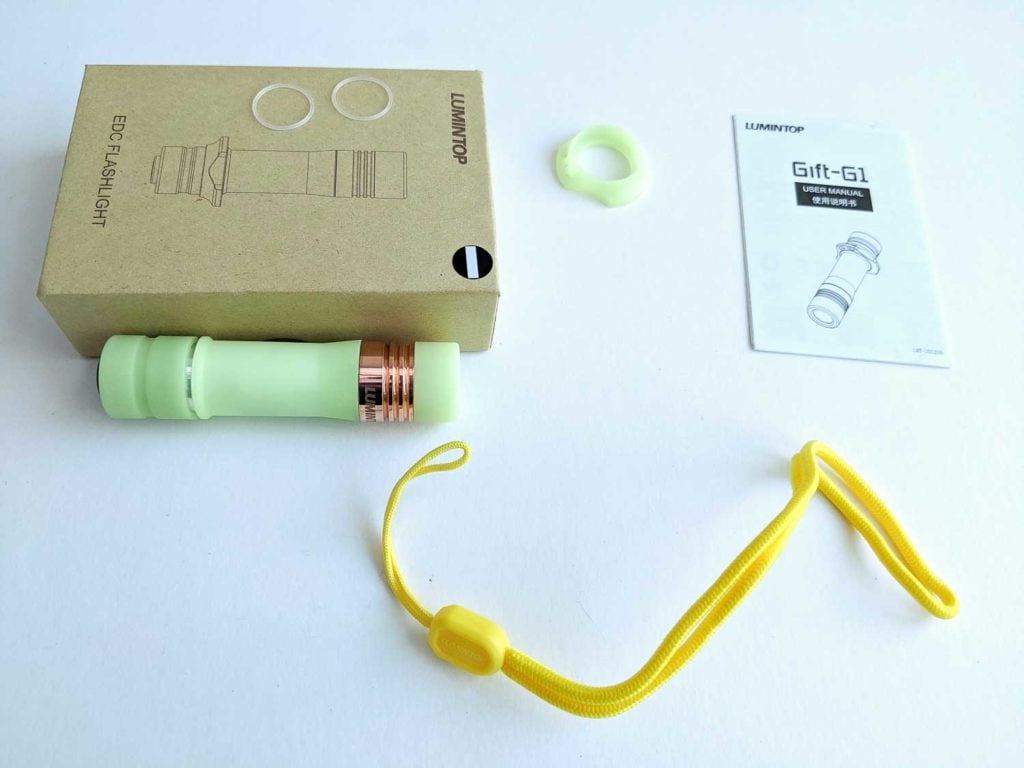
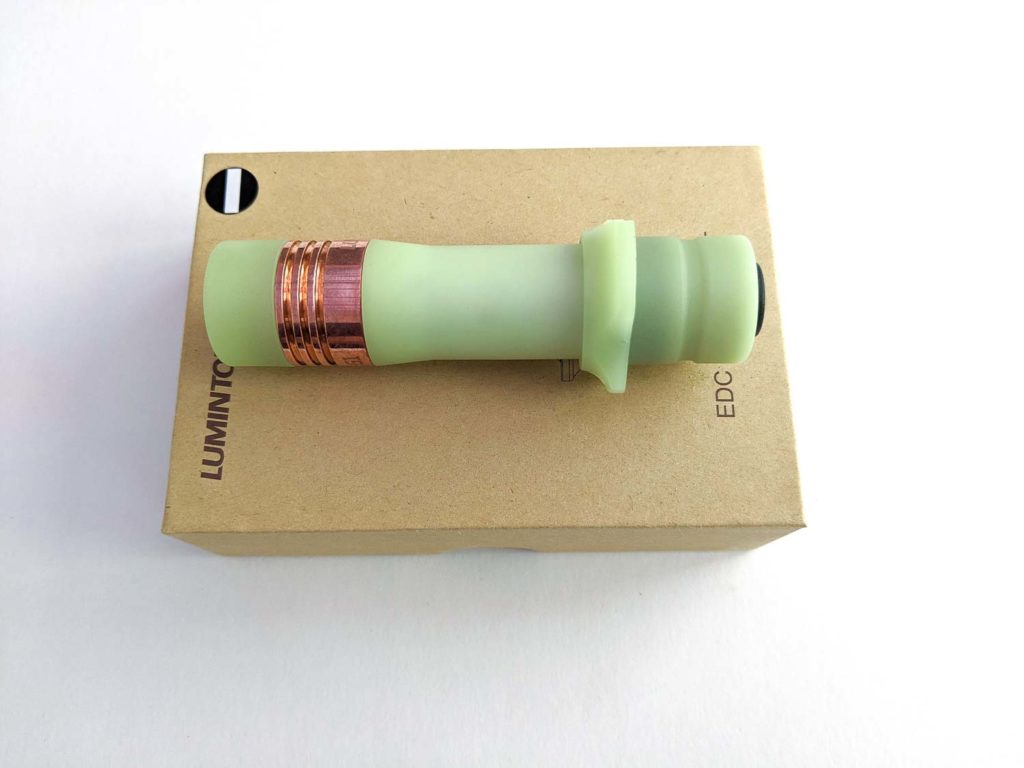
Flashlight in use
The plastic GITD body is fairly smooth. Even so, being an AA-sized light, you’re unlikely to drop it. I don’t many AA flashlights, so the Gift-G1 is noticeably smaller than 18650 flashlights.
The tail switch is mechanical but it has electronics inside it, so you could call it an e-switch. It’s a reverse clicky, which means a half click will only turn off when it’s already on. It’s not a tactical light at all, as you can’t half press for momentary on. The switch sticks out a bit but it’s flat, so the flashlight just manages to tail stand on it on a flat surface, with a bit of a wobble.
The tactical ring (cigar grip) is a nice addition but means it won’t fit so well in small pockets. With the cigar grip it’s easier to hold and activate the tail switch. I normally prefer side switches but the Gift-G1 with the tactical ring is a nice combo. Although you use the light without the ring, doing so will leave a 2mm gap of exposed aluminium, so it doesn’t look so good. The ring also stops the Gift-G1 from rolling and also includes 2 holes for the lanyard.
The absence of a clip limits how the Gift-G1 can be carried. I’d have liked to see one provided but I’m not sure if it’d work with the plastic.

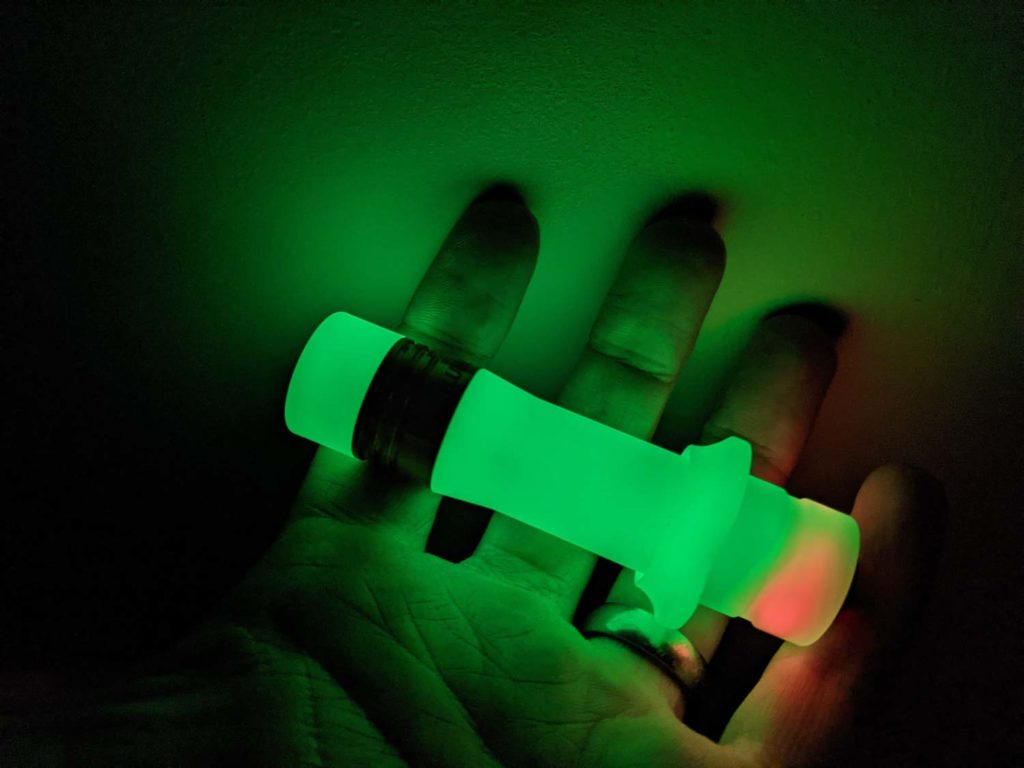
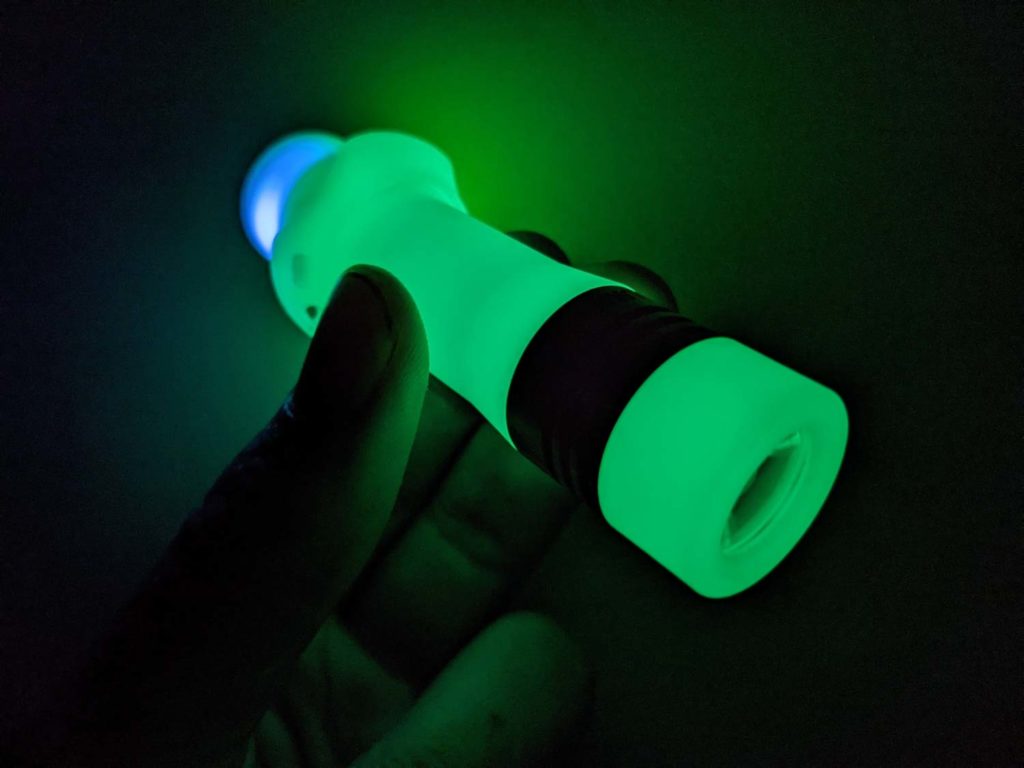

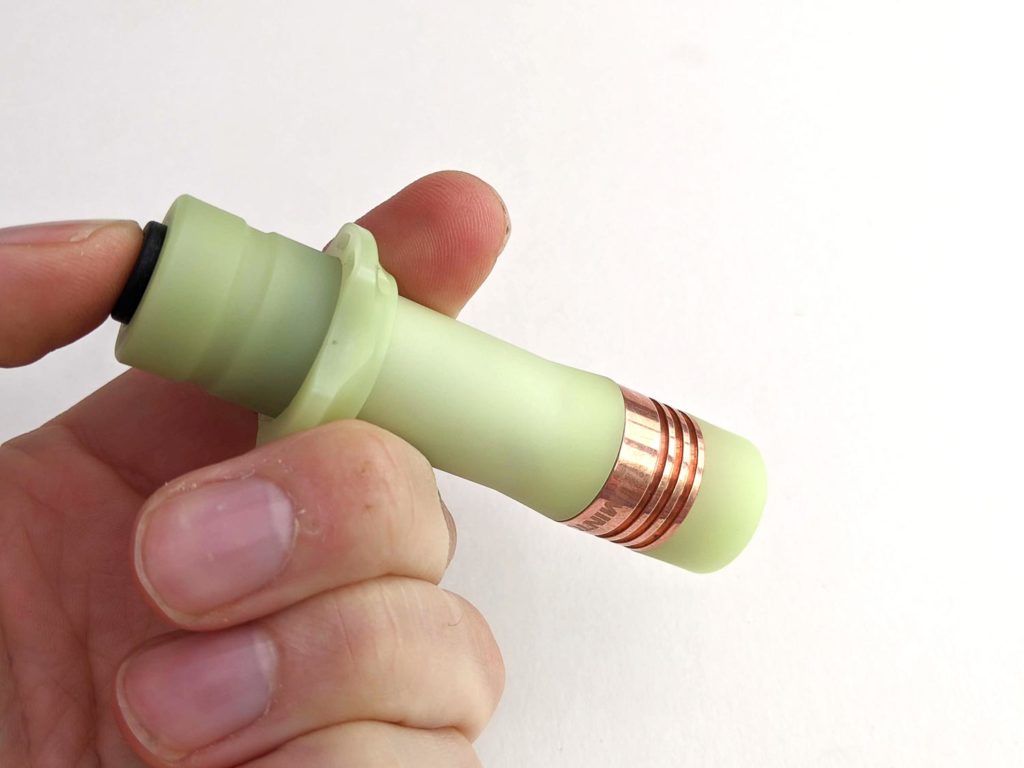
Build Quality, and Warranty
From a quick glance the Lumintop Gift-G1 looks like a cheap kids flashlight. But after a moment you’ll realise that it’s actually a quality flashlight. The copper head stands out and adds heft to the light.
The GITD plastic surrounds an aluminium body tube. This results in the 3 sets of threads all being different pairs of materials. The tail threads are aluminium and plastic. These have been greased, resulting in the plastic inside going a bit grey. Aluminium and copper meet at the head. These aren’t greased but still turn fine. Finally, the plastic bezel threads on to the copper at the head. All the threads are square cut and smooth.
Lumintop provide a 30-day warranty with free repair or replacement for defects. They also provide a free 5-year warranty for repairs, aside from wear and tear.
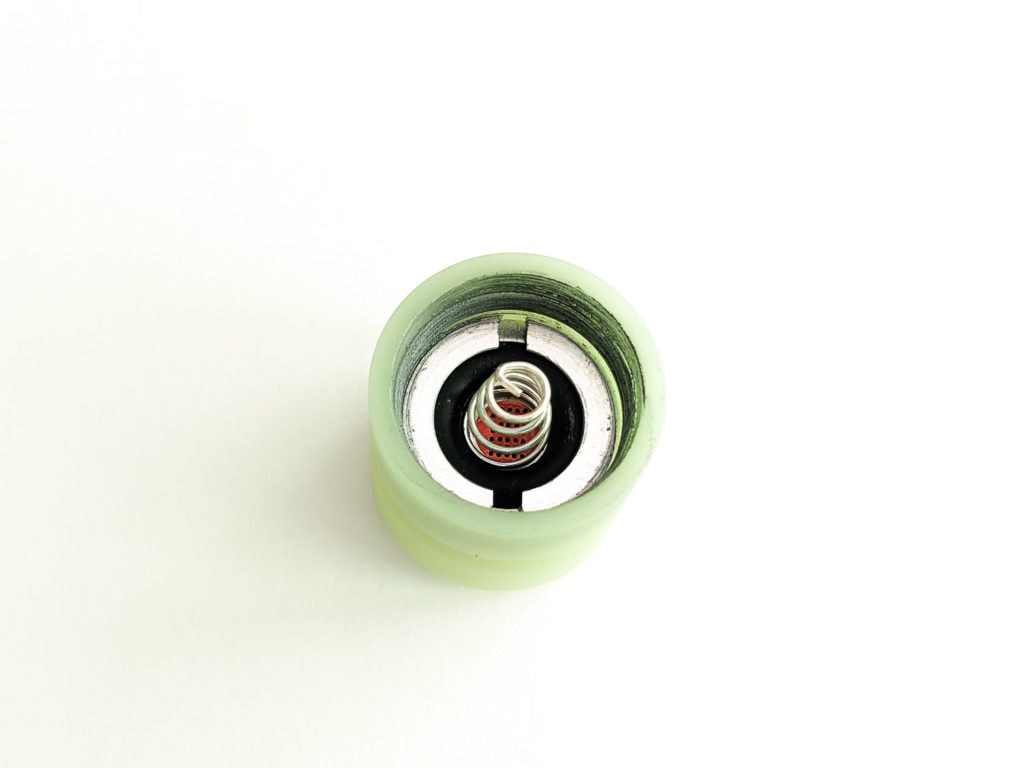
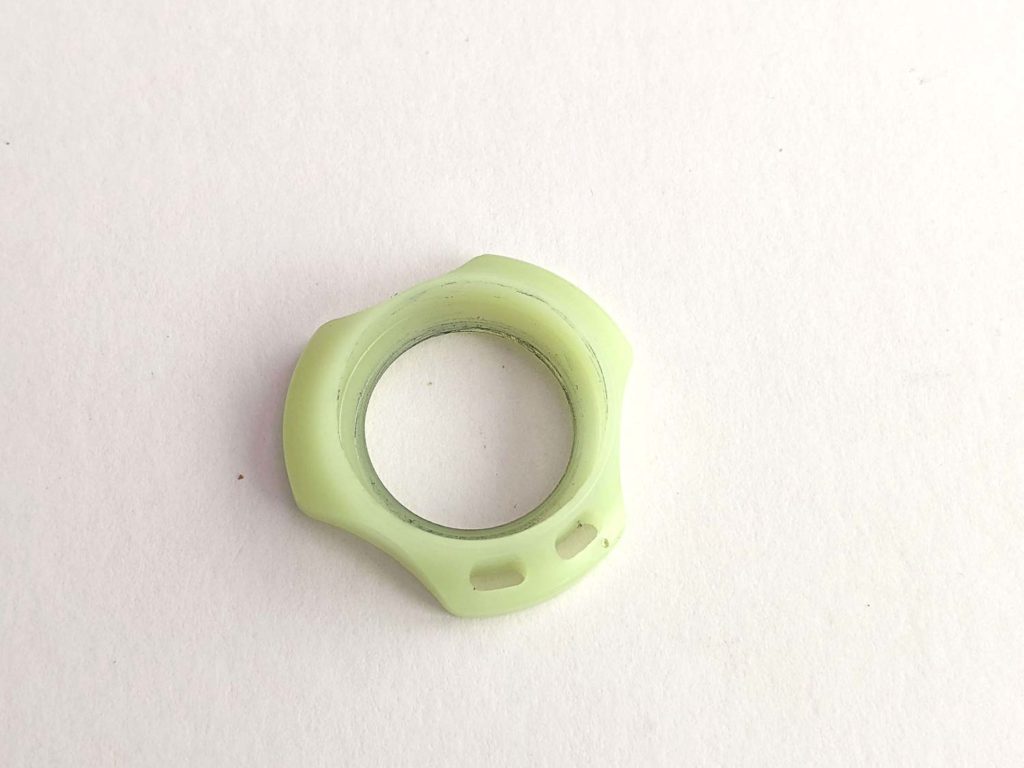
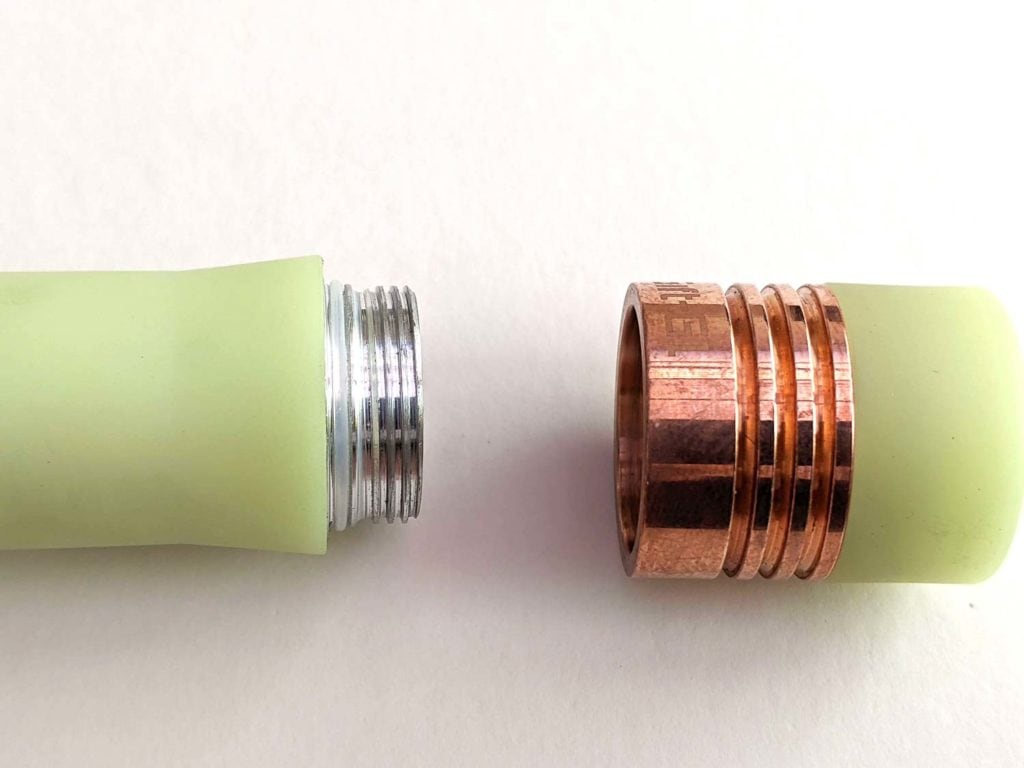
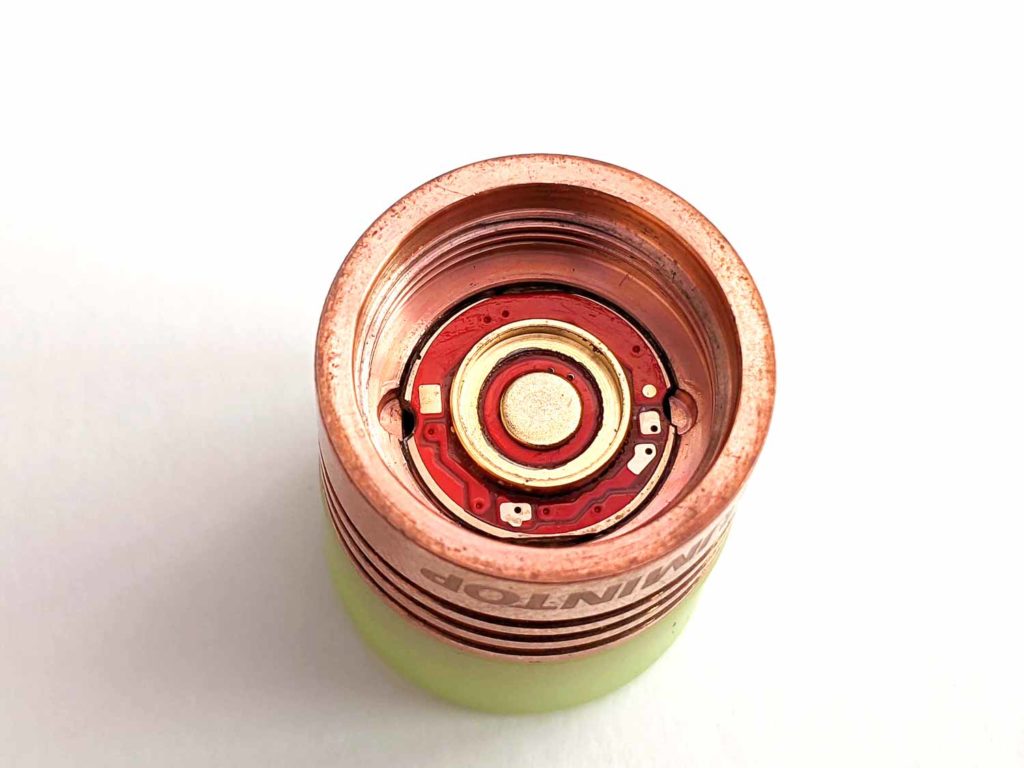
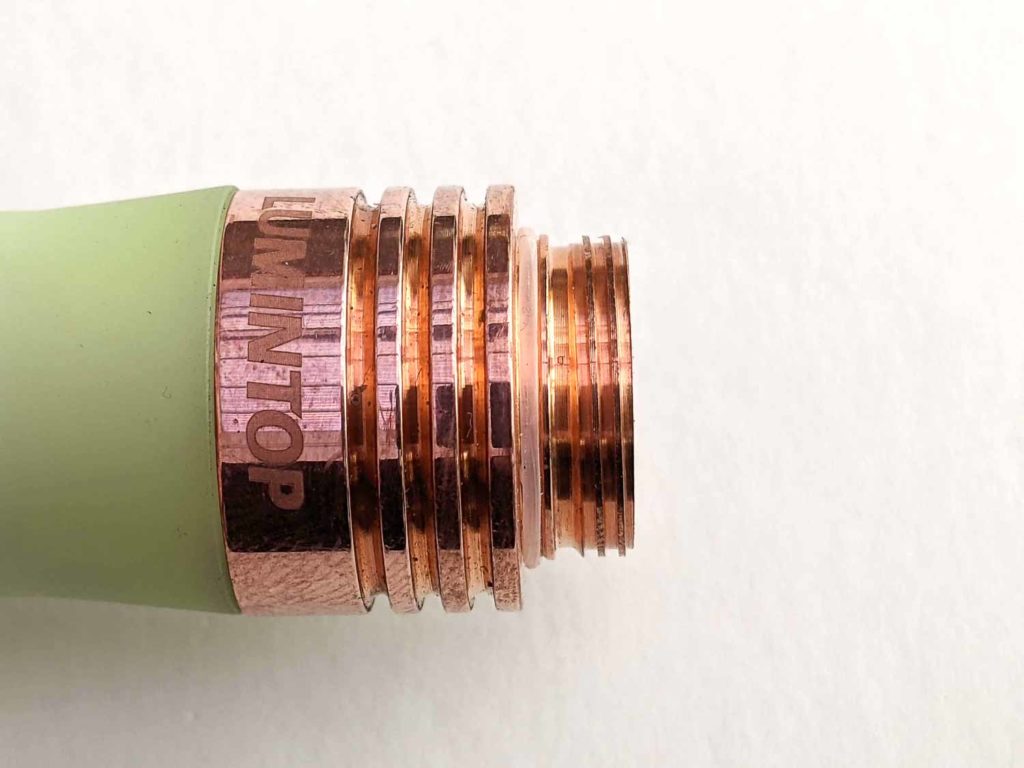

LED, Lens, Bezel, and Reflector
Glow in the dark
Let’s start with the glow-in-the-dark aspect first. It’s great but to be honest with all the hype I was expecting a bit more. There isn’t much difference between the glow of the Gift-G1 and some glow in the dark tape
When fully charged all over by another light the glow of the Gift-G1 probably gives off about 1 or 2 lumens. Obviously, the glow isn’t directed with an optic, so it’s more like a light bulb or lantern and hard to compare to flashlights. In any particular direction, the Gift-G1’s glow lights things up significantly more than my Zebralight on the 0.01 lumen mode and is bright enough to read a book with.
Turning on the LED for a bit will make just the bezel area of the Gift-G1 glow. Even just this part by itself is still fairly bright. Unlike auxiliary lights on an Anduril flashlight, there’s no way to turn off the glow – I found it was annoyingly noticeable after messing around with it and then trying to get kids to bed!
After a couple of minutes the Gift-G1 starts to lose its glow. After an hour the glow is still visible but gives off less light than the 0.01 lumen Zebralight. It’s still easy to see the Gift-G1 in the dark but it doesn’t give enough light to see other things. There’s still a little glow after 12 hours, so it would help finding the light overnight when camping or similar. It might also work well as a gradually-fading night light for kids.
In the photos you can see the Gift-G1, a Zebralight on 0.01 lm and some standard GITD tape. The Gift-G1 and tape easily overpower the Zebralight. Then after 1 hour the Gift-G1 is dimmer than the Zebralight but still a bit brighter than the GITD tape.
Lighted tail cap
As well as the GITD plastic, the Gift-G1 has a lighted tailcap. This is made up of 2 RGB LEDs that smoothly fade all the colours of the rainbow.
The tailcap is on when the main LED is off and off when it’s on. Note that the tail cap LEDs only work when using a 14500 cell, not a regular AA.
Main LED
Behind the GITD bezel is a plastic TIR optic, 14.7mm in diameter and 9.0mm deep. There’s no glass lens and the TIR is only recessed by 2mm, so the plastic may get scratched if you’re not careful. The TIR focuses the light and results in a fairly throwy light for its size.
The LED sits on a MCPCB behind the TIR and a plastic spacer. I didn’t measure the MCPCB but if you want to replace it, the inner diameter of the copper is 13.7mm. As seen in some other Lumintop lights, there’s 3 wires coming up from the driver: 2 that go to the MCPCB and 1 that goes to the host.
The LED itself is a neutral white Nichia 219C that looks to be 5000K. This one seems dead on the BBL, without a hint of green or pink. You can also get the Gift-G1 with a cool white CREE XP-G3. The CREE option will be 30% brighter and 100% uglier than the Nichia.

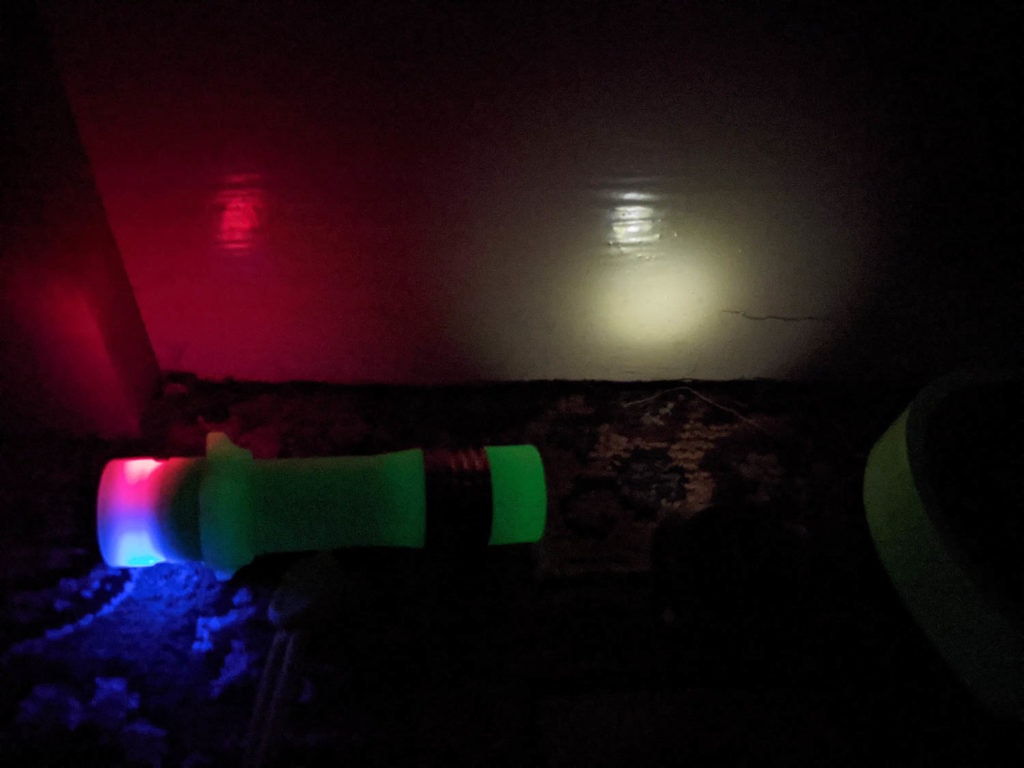
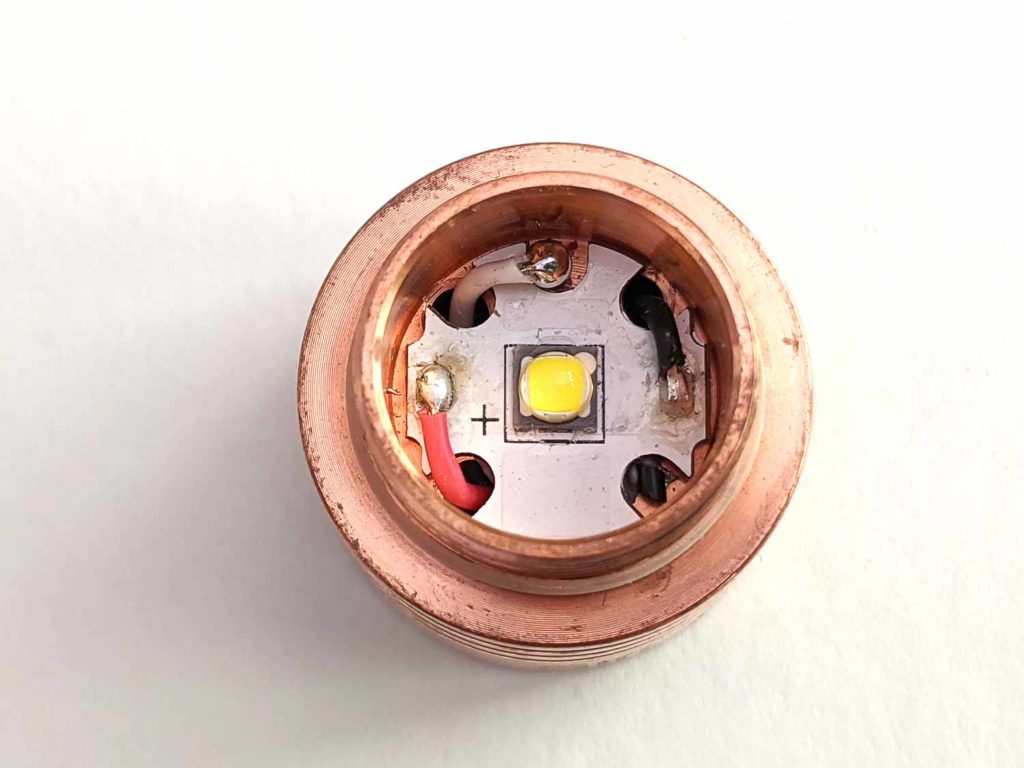
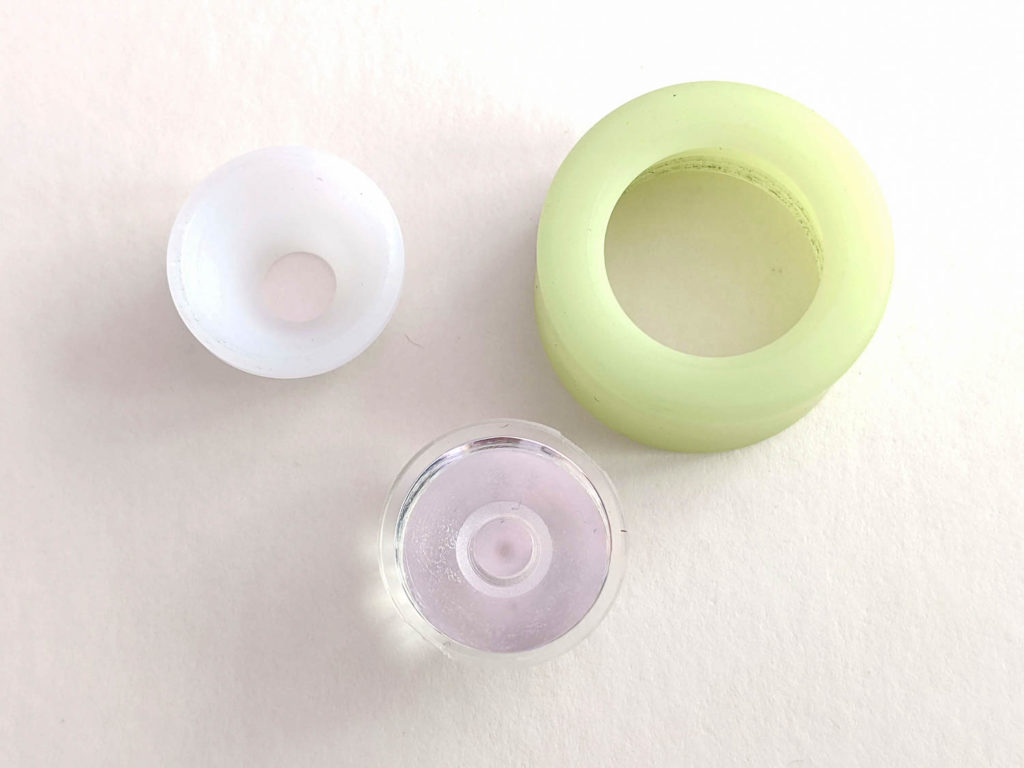
Dimensions and size comparison
- Length: 8.82 cm / 3.47 inches
- Head diameter: 2.10 cm / 0.82 inches
- Body diameter: 2.09 cm / 0.82 inches
Weight:
- With cell: 72g / 2.5 oz
- Without cell: 50g / 1.8 oz
EDC Flashlight comparison
EDC flashlight size comparison
From left to right:
- Lumintop GT Nano
- Zebralight H53w
- Lumintop Gift-G1
- SingFire SF-348
- Thorfire TK-5
- Astrolux A02
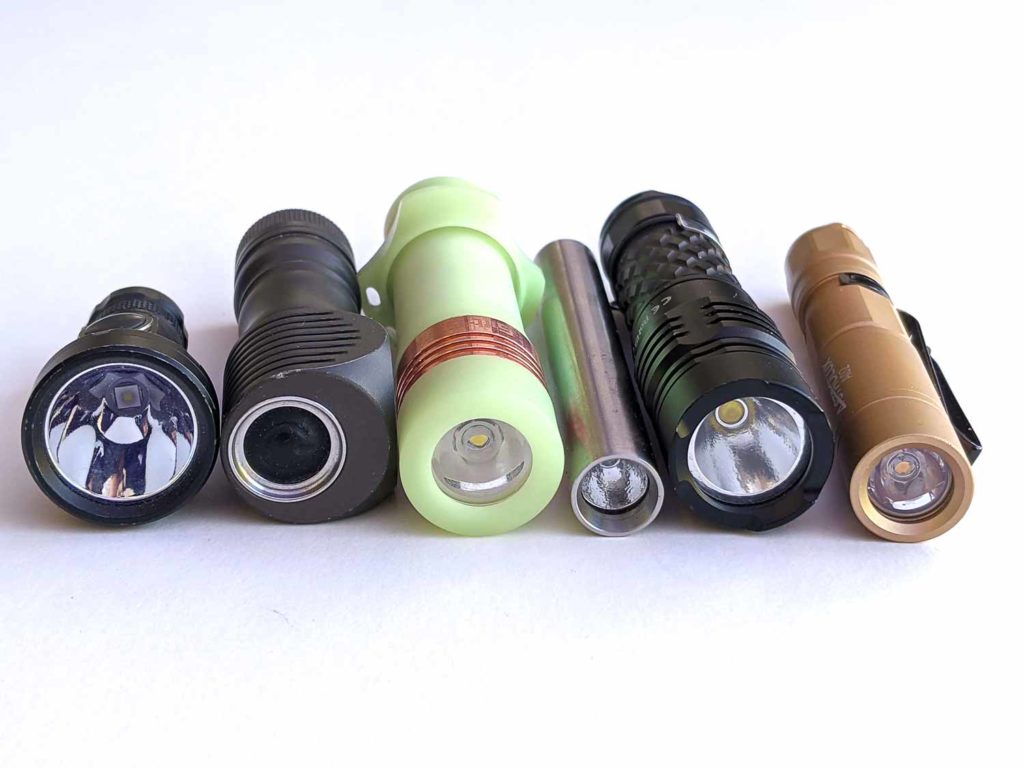

Driver & User Interface:
Unfortunately, the Lumintop Gift-G1 has next mode memory when using a 14500 cell. This means that every time you turn it on, it will cycle on to the next mode. This is the worst kind of user interface and is like playing Russian roulette with the turbo mode.
Thankfully, with an AA battery the Gift-G1 has normal mode memory. That means after 2 seconds of being off, it will return to the same mode when you next turn it on. This is much better than next mode memory, though personally, I prefer knowing that a light will always start in the lowest mode.
The UI difference between the cells seems to be because of the lighted tail cap, which only works with the higher voltage of the 14500. With the 14500 the tail cap is lit up and the driver never fully turns off, so it thinks it should go onto the next mode. Thanks to Gabriel for explaining this, who also suggested that adding a bleeder resistor should allow the driver to fully turn off and probably fix the issue.
The lighted tail cap draws between 370µA and 800µA (almost 1mA), depending on the colour. This is about 40 days on a 1000mAh cell, so make sure to twist the tail cap if you’re not using it for a while.
You can also turn the Gift-G1 off by unscrewing the tail cap. The tail cap light then turns off too, and the driver has normal mode memory.
The driver is about 12mm diameter and has a metal ring to prevent cells going in the wrong way.
Modes: Low, Med, High, Turbo
From OFF:
- Click: on (AA: mode memory, 14500: next mode memory)
From ON:
- Click: off
- Tap: next mode (L-M-H-T, then back to low)
- Tap 6 times: strobe
Mode memory:
- Normal mode memory with an AA cell or when you unscrew the tail cap. Next mode memory when using an 14500 cell.
Low voltage warning:
- Yes, the light will switch off when a 14500 cell gets to 2.73V and when an AA gets to about 0.7V.
Strobe
- 6 taps from on
Lock-out mode:
- You can twist the tail cap to lock the light out.
PWM
- Not visible by eye but my camera picked up PWM on all modes on the 14500 and just low on the AA.
Batteries & Charging
The Gift-G1 takes both 14500 li-ion cells and standard AA batteries. It requires button top cells due to the physical reverse polarity protection on the driver.
A 51.4mm 14500 button top was fine, as was a 50.3mm Eneloop.
Performance
Lux meter: All lux and lumen measurements are from my homemade integrating sphere, calibrated with a range of factory specced lights. Measurements are done with a UNI-T UT383S lux meter and Adafruit TSL2591 connected to a Raspberry Pi (using RuTiTe by bmengineer). Expect them to be within +/-10%.
DMM: Current readings were taken with a Precision Gold PG10B DMM, all with the cells fully charged.
Amp and lumen measurements
AA (standard Eneloop)
| Mode | Current (A) | Spec (lm) | Measured (lm) |
| Low | 20mA | 1.3 lm | 1 lm |
| Medium | 164mA | 18 lm | 22 lm |
| High | 0.95A | 110 lm | 119 lm |
| Turbo (0s) | 3.65A | – | 177 lm |
| Turbo (30s) | – | 165 lm | 140 lm |
| Turbo (10m) | – | – | 140 lm |
14500 (Ampsplus 10A 1000mAh)
| Mode | Current (A) | Spec (lm) (Nichia) | Measured (lm) |
| Low | 21mA | 7 lm | 8 lm |
| Medium | 102mA | 55 lm | 60 lm |
| High | 1.00A | 300 lm | 378 lm |
| Turbo (0s) | 1.89A | – | 671 lm |
| Turbo (30s) | – | 500 lm | 633 lm |
| Turbo (10m) | – | – | 342 lm |
Whilst my measurements with an Eneloop were close to specs, I was getting consistently high numbers with a high drain 14500 cell. I had to double check and compare against some other lights. The Gift-G1 is noticeably brighter than other lights around 400-500 lumens.
Runtime graph

Lots of lines here, so apologies if you’re colour blind. With the 14500, you can see turbo holding 600 lm for 45 seconds, then after 1 minute it’s at the same level as high. The 14500 keeps dropping slowly and lasts about 1 hour 20 on turbo or high.


Turbo with an AA dropped down quicker but not as much. You can see the boost driver at work with the AA, keeping the flat line instead of the linear drop with the 14500. At about 1 hour the steady line of the AA is still going, meaning the slowly dimming 14500 is now not as bright. The AA lasts 1 hour 30 on turbo and 2 hours on high.
Medium on either cell lasts a long time. At 7 hours the AA was still going level but the gradual decline of the 14500 had gone below 20 lumens. The 14500 finally got below 1 lumen around 11 hours. The AA suddenly cut out at 14 hours.
Throw numbers (14500):
| Mode | Spec | Measured |
| Low | – | 0m / 0 cd |
| Medium | – | 37m / 344 cd |
| High | – | 100m / 2478 cd |
| Turbo (0s) | – | 135m / 4543 cd |
| Turbo (30s) | 125m / 4050 cd | 130m / cd |
Beamshots
Photos were taken with a Pixel 3a, set to 1/2s shutter speed and ISO 400, F1.8. White balance was locked on cool white.
Distance to the bench is 6m, tree on the right is 13m, tree on the centre right is 18m and the building behind it is 69m.
Beamshots:
- Emisar D4V2 (4000K)
- Lumintop D1 (3000K)
- Lumintop Gift-G1 (5000K)
- Jetbeam EC26
- Lumintop FW4x
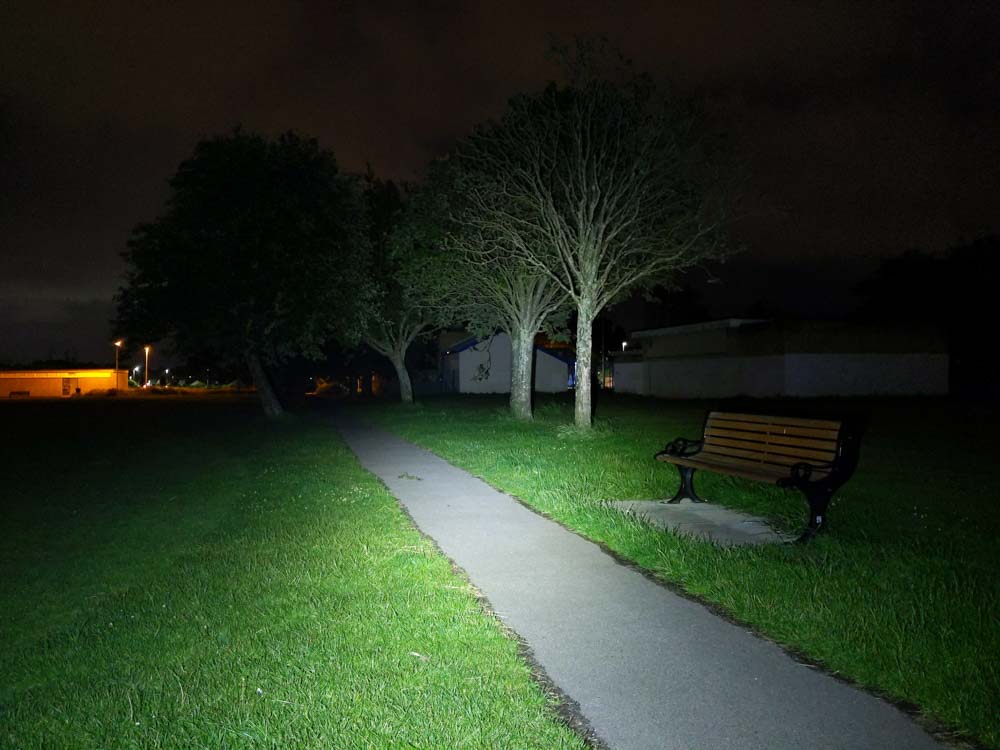




Disclaimer: This flashlight was sent to me for review at no cost by Lumintop. I have not been paid to review, nor have I been holding back on problems or defects.
Explanation on star ratings:
- – Avoid: my phone flashlight would be a better choice
- – Poor: significant defect or issues, much better options available at the same price
- – Average: some defects or issues
- – Good: recommended (minor issues)
- – Great: highly recommended
Final Verdict
Pros
- It glows and lights up!
- Takes AA or 14500
- Good build quality, especially considering it’s plastic
- Performs very well with 14500
Cons
- Next mode memory with 14500
- No clip
- Tailcap doesn’t light with AA
- No lens over the TIR

4 stars: ★★★★★
Thanks to almost the whole body being glow-in-the-dark, the Lumintop Gift-G1 is a very fun light and different to any other light I own. It also performs really well with a 14500. Despite that, it only gets 4 stars from me.
The next mode memory you get when you use a 14500 kills it for me and means I’ll only ever use it with an AA battery. Being restricted to the AA means the lighted tail cap doesn’t work and limits it to about 150 lumens (with the Nichia). That’s OK but not especially bright for a light of its size. If you like to be surprised every time you turn on your flashlight by an unknown amount of light then the Gift-G1 with 14500 is for you!
I’ve raised lots of issues with the Gift-G1 but I still enjoy using it. Maybe less as an EDC tool but as something a bit different to play with. If you’re OK with it not being the perfect EDC flashlight then you’ll enjoy the Lumintop Gift-G1.
Lumintop Gift G1 for sale:
1lumen selects and reviews products personally. We may earn affiliate commissions through our links, which help support our testing.